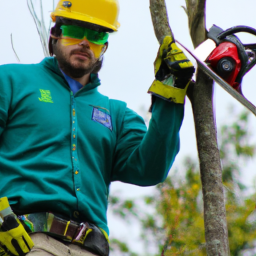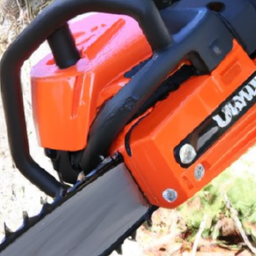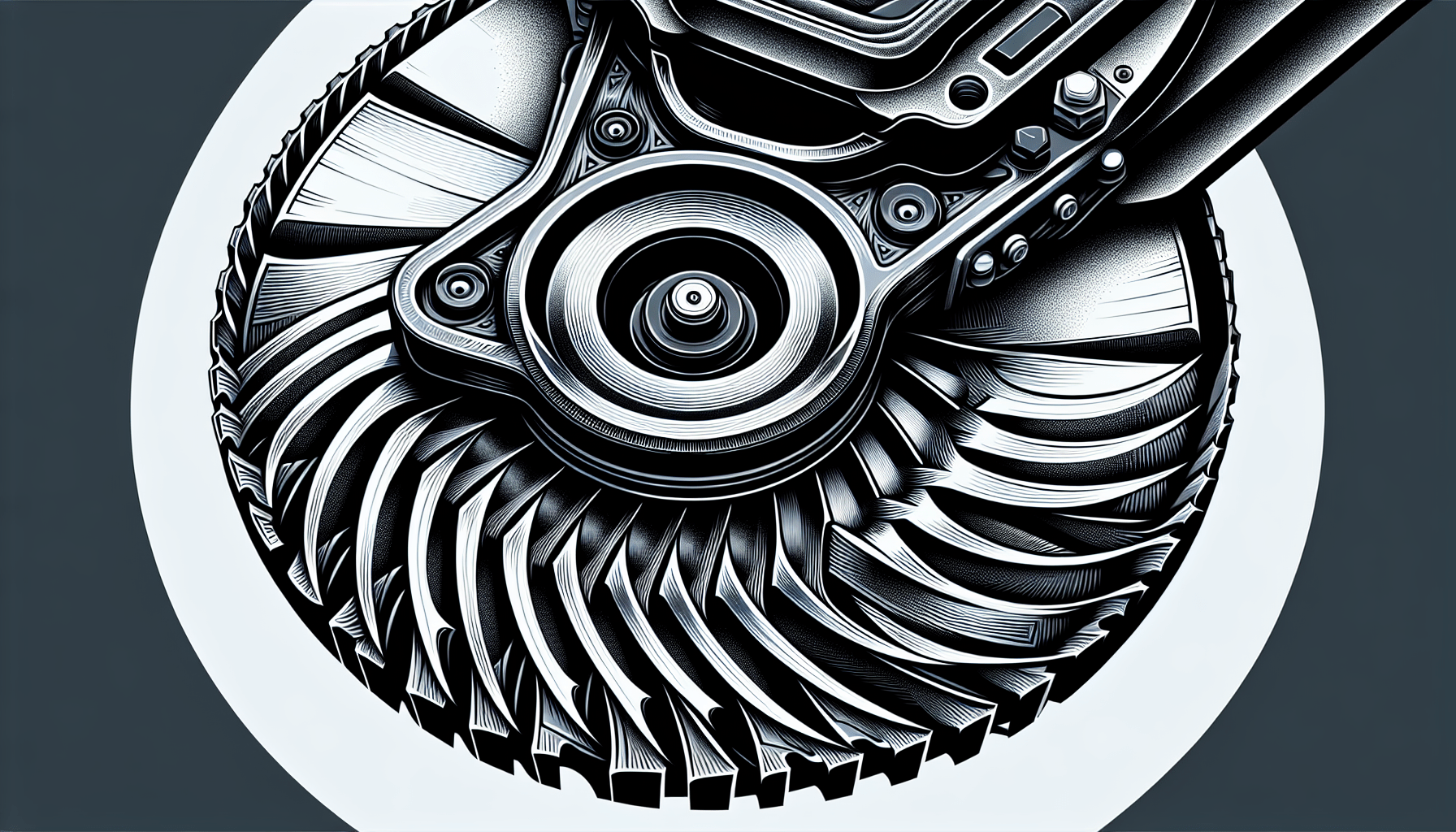The Ryobi Pole Saw Attachment is a versatile tool that allows you to conveniently trim and prune trees without the need for a ladder. In this guide, you will discover everything you need to know about using this attachment, from assembling and attaching it to your Ryobi powerhead, to effectively and safely operating the pole saw. Whether you’re a seasoned tree-care professional or a novice with a green thumb, this comprehensive guide will ensure that you get the most out of your Ryobi pole saw attachment and achieve impressive results. So, grab your Ryobi powerhead, prepare to elevate your tree-trimming game, and let’s dive into the world of this fantastic tool!
Safety Precautions
When using the Ryobi Pole Saw Attachment, it is essential to prioritize safety. By taking a few simple precautions, you can mitigate the risk of accidents and ensure a safe working environment.
Wear appropriate safety gear
Before starting any work with the pole saw, it is crucial to wear the right safety gear. This includes a helmet, safety glasses, hearing protection, gloves, and sturdy work boots. The helmet will protect your head from falling branches, while safety glasses shield your eyes from any debris that may fly during the cutting process. Wearing gloves will provide you with a better grip and protect your hands from potential cuts or blisters. Lastly, sturdy work boots will ensure stability and reduce the risk of slipping or tripping while operating the pole saw.
Inspect the pole saw attachment before use
Before using the Ryobi Pole Saw Attachment, carefully inspect it for any damage or wear. Check the cutting blade, chain, and the attachment’s overall condition. If you notice any signs of damage or wear, it is crucial to address them before starting your cutting tasks. This will help prevent any accidents or malfunctions that could occur while operating the pole saw.
Clear the work area of debris
Before operating the pole saw, it is essential to clear the work area of any debris, such as fallen branches or loose objects. This will minimize the risk of tripping or getting entangled in debris while using the pole saw. It is crucial to create a clean and clutter-free environment to ensure safe and efficient operation.
Avoid working near power lines
One of the most critical safety precautions when using the pole saw attachment is avoiding working near power lines. Always be aware of your surroundings and identify the location of power lines before starting any cutting tasks. Maintain a safe distance from power lines to prevent accidental contact, which can be extremely dangerous and potentially life-threatening. It is always better to be safe and work far away from power lines.
Use caution on uneven or unstable surfaces
When using the pole saw attachment, it is important to be cautious when working on uneven or unstable surfaces. Uneven ground or slippery conditions can increase the risk of accidents or falls. Before starting your work, ensure that you have a stable footing, and be mindful of any surface irregularities. This will help you maintain balance and stability while operating the pole saw.
Assembling the Pole Saw Attachment
Now that you are familiar with the safety precautions, let’s move on to assembling the Ryobi Pole Saw Attachment. Proper assembly is crucial to ensure optimal performance and safety during operation.
Attach the pole saw attachment to the Ryobi power head
To begin assembling the pole saw attachment, secure the attachment to the Ryobi power head. Line up the attachment’s connection point with the power head’s output shaft. Carefully slide the attachment onto the output shaft until it is fully seated and secure. Ensure that the attachment is aligned correctly before proceeding.
Secure the attachment with the provided screws
Once the attachment is in place, use the provided screws to secure it tightly to the power head. Insert the screws into the designated holes and tighten them securely. This step is vital to maintain a stable connection between the attachment and the power head, ensuring safe and efficient operation.
Ensure a tight and stable connection
After attaching the pole saw attachment to the power head, ensure that the connection is tight and stable. Wiggle the attachment gently to check for any loose parts or wobbling. If you notice any instability or movement, double-check the assembly and tighten the screws if necessary. A secure connection will minimize the risk of accidents and promote smooth operation of the pole saw attachment.
Preparing the Pole Saw for Use
Once the pole saw attachment is assembled and securely attached to the Ryobi power head, it’s time to prepare the pole saw for use. Follow these steps to ensure a smooth and efficient cutting experience.
Check the chain tension
Before starting your cutting tasks, make sure to check the chain tension. A properly tensioned chain ensures smooth and effective cutting. If the chain is loose, follow the manufacturer’s instructions to adjust the tension accordingly. Conversely, if the chain is too tight, loosen it slightly to prevent unnecessary strain on the pole saw attachment and damage to the chain.
Fill the oil reservoir
The pole saw attachment requires lubrication for optimal performance and longevity. Fill the oil reservoir with the recommended bar and chain oil, following the manufacturer’s instructions. Adequate lubrication reduces friction and keeps the chain running smoothly during operation. Regularly monitor the oil level and refill it as needed to ensure continuous lubrication.
Check the fuel level of the power head
If your Ryobi power head operates on fuel, it is essential to check the fuel level before starting the job. Running out of fuel in the middle of your cutting tasks can be inconvenient and disrupt your workflow. Fill the fuel tank to the recommended level, following the manufacturer’s instructions. This will ensure that the power head has sufficient fuel to operate without interruptions.
Start the Ryobi power head
Once you have checked the chain tension, filled the oil reservoir, and confirmed the fuel level, it’s time to start the Ryobi power head. Follow the manufacturer’s instructions for starting the specific model of power head you are using. Typically, this involves a combination of activating the choke, priming the engine, and pulling the starter cord. Pay attention to the specific starting procedure to ensure a successful start.
Allow the engine to warm up
After starting the power head, allow the engine to warm up for a few minutes before beginning your cutting tasks. Warming up the engine improves its overall performance and ensures smooth operation. During this time, you can double-check your safety gear, inspect the work area, and mentally prepare for the upcoming cutting tasks. A short warm-up period will help optimize the performance of your pole saw attachment.
Operating the Pole Saw
With the pole saw attachment properly assembled and the necessary preparations complete, it’s time to begin operating the Ryobi Pole Saw. Proper operation techniques are essential for a safe and efficient cutting experience. Follow these steps to get the best results.
Hold the pole saw securely with both hands
When operating the pole saw attachment, it is crucial to maintain a secure grip and hold it with both hands. Grip the pole saw handle firmly and position your hands at a comfortable distance from the cutting blade. This grip will provide stability and control while cutting through branches. Avoid gripping the pole saw too tightly, as it may cause fatigue or hinder your ability to maneuver the tool effectively.
Position the cutting blade correctly
Before engaging the throttle and starting the cutting process, ensure that the cutting blade is positioned correctly. The blade should be parallel to the branch you intend to cut, with the chain teeth facing away from you. This alignment ensures that the cutting action is efficient and reduces the risk of kickback. Take a moment to adjust the angle of the blade if needed, ensuring it is aligned perfectly before proceeding.
Engage the throttle and start cutting
With the pole saw properly positioned and aligned, engage the throttle to start the cutting process. Gradually increase the speed of the chain to full throttle, allowing it to reach its maximum cutting power. Be cautious and attentive while operating the pole saw, focusing on maintaining control and a steady cutting motion.
Maintain a steady cutting motion
When cutting through branches, it is important to maintain a steady cutting motion. Apply gentle pressure to the cutting blade and allow the chain to do the work. Avoid exerting excessive force or pushing the blade forcefully through the branches. Let the pole saw’s cutting power and motion guide the blade through the wood smoothly. This technique reduces the risk of accidents and ensures a clean and precise cut.
Avoid forcing the blade through the branches
As mentioned earlier, avoid forcing the blade through the branches. Let the pole saw’s cutting power and sharp blades do the work for you. Forcing the blade can lead to kickback, which can be dangerous and cause the pole saw to lose control. Take your time, work methodically, and let the pole saw’s cutting action guide you through each cut. This patient approach will ensure efficiency and safety throughout the cutting process.
Cutting Techniques
To get the best results with the Ryobi Pole Saw Attachment, it is helpful to follow specific cutting techniques. These techniques will enhance your cutting efficiency and promote safety during operation.
Cut at a slight angle
When cutting branches with the pole saw attachment, it is advisable to cut at a slight angle. A slight angle allows the branch to fall away from the tree or structure, preventing potential damage or injuries. Angling the cut also helps maintain balance and control while operating the pole saw. Take your time and make precise angled cuts for optimal results.
Start from the bottom and work your way up
When tackling a tree branch, it is best to start cuts from the bottom and work your way up. Begin by making an initial undercut on the underside of the branch, a few inches away from the trunk. This will prevent the branch from splitting or tearing as you make the final cut from the top. Working from the bottom up also provides better stability and control while cutting through larger branches.
Be aware of kickback
Kickback is a sudden, upward motion of the pole saw that can occur when the blade becomes jammed or encounters resistance. To prevent kickback, always maintain a firm grip on the pole saw and be mindful of its position. Avoid sawing with the tip of the blade and be cautious when working near the branch ends, as these areas are more prone to kickback. By being aware of kickback and using proper cutting techniques, you can minimize the risk of accidents and injuries.
Avoid cutting above shoulder height
When operating the pole saw attachment, it is recommended to avoid cutting above shoulder height. Working within a comfortable range lowers the risk of fatigue and provides better control over the tool. Additionally, cutting branches above shoulder height can lead to awkward body positions and compromised balance, potentially increasing the risk of accidents. Focus on maintaining an ergonomic and balanced posture while cutting.
Clear the branches as you go
To ensure safe and efficient cutting, clear the branches as you go. Removing cut branches from the work area reduces the risk of tripping or entanglement in debris. Keep an eye on the area beneath the branch you are cutting and promptly clear any fallen branches. This practice maintains a clean work area, allowing you to work safely and smoothly with the pole saw.
Maintaining the Pole Saw
Proper maintenance of the Ryobi Pole Saw Attachment is crucial for its long-term performance and durability. Regular maintenance ensures that the tool operates smoothly and safely, providing you with optimal cutting results.
Regularly clean and oil the cutting blade
After each use, take the time to clean and oil the cutting blade of the pole saw attachment. Remove any debris, sawdust, or resin that may have accumulated on the blade during operation. Cleaning the blade prevents build-up that can affect cutting efficiency and causes unnecessary strain on the motor. After cleaning, apply a thin layer of lubricating oil to the blade to prevent rust and ensure smooth operation.
Inspect the chain for damage or dullness
Regularly inspect the chain of the pole saw attachment for any signs of damage or dullness. Look for broken or missing chain links, bent teeth, or excessive wear. A damaged or dull chain can compromise the cutting performance and increase the risk of accidents. If you notice any issues, replace the chain with a new one following the manufacturer’s instructions.
Use appropriate bar and chain oil
To maintain optimal performance, it is important to use the recommended bar and chain oil for the pole saw attachment. Bar and chain oil is specifically designed to lubricate the cutting blade and reduce friction during operation. Using an alternative oil or lubricant may not provide the same level of lubrication and protection for the pole saw attachment. Always refer to the manufacturer’s guidelines for the appropriate oil to use.
Tighten any loose screws or bolts
Over time, the vibrations and movements involved in cutting tasks may cause screws or bolts to become loose. Regularly inspect the pole saw attachment for any loose screws or bolts and tighten them if necessary. Ensuring that all components are securely fastened reduces the risk of accidents during operation and promotes stable and efficient cutting.
Store the pole saw attachment properly
Proper storage of the pole saw attachment is essential for its longevity. After each use, clean the attachment and remove any sawdust or debris. Store it in a dry and secure location, away from extreme temperatures or humidity. This will prevent rust and damage to the tool. Additionally, consider using the original packaging or a protective case designed specifically for the pole saw attachment to provide extra protection during storage.
Troubleshooting Common Issues
While the Ryobi Pole Saw Attachment is designed for reliable performance, you may occasionally encounter some common issues. Understanding how to troubleshoot these problems can save you time and frustration, allowing you to get back to your cutting tasks quickly.
Chain not moving
If you find that the chain is not moving when the pole saw attachment is on, there may be an issue with the chain tension, the drive gear, or the power head. Start by checking the chain tension and adjusting it if needed. Ensure that the drive gear is engaged and moving correctly. If these steps do not resolve the issue, consult the manufacturer’s troubleshooting guide or contact their customer support for further assistance.
Lack of cutting power
If you notice a lack of cutting power, it could be due to a few different factors. First, check the chain tension and ensure it is properly tensioned. Next, inspect the chain for sharpness or dullness. If the chain is dull or damaged, it may need to be replaced or sharpened. Lastly, check the power head for any issues, such as a clogged air filter or an improperly adjusted carburetor. Addressing these potential causes can help restore the cutting power of the pole saw attachment.
Excessive vibration
Excessive vibration during operation can be uncomfortable and affect cutting efficiency. If you experience excessive vibration, start by checking the chain tension and adjusting it if necessary. Ensure that the attachment is securely attached to the power head, and all screws are tight. Examine the chain for any signs of damage or unevenness. If the issue persists, it may be beneficial to consult the manufacturer or a professional for further assistance.
Engine stalling
If the engine of the power head regularly stalls during use, there may be an issue with the carburetor, fuel filter, or spark plug. Start by checking the fuel filter for any clogs or restrictions. Inspect the spark plug for signs of damage or wear, and replace it if necessary. If the problem continues, consider consulting the manufacturer’s troubleshooting guide or seeking professional assistance.
Chain getting stuck
If the chain frequently gets stuck while cutting, it may be due to a variety of factors. Check the chain tension and adjust it if necessary. Ensure that the chain is correctly aligned with the cutting blade and not twisted or caught on any debris. If the issue persists, examine the condition of the chain itself. If the teeth are damaged, dull, or uneven, it may be time to replace or sharpen the chain. Proper chain maintenance and attention to cutting technique can prevent the chain from getting stuck.
Tips for Efficient and Effective Use
To make the most of your Ryobi Pole Saw Attachment and ensure a productive cutting experience, keep these tips in mind:
Take breaks to avoid fatigue
Using a pole saw attachment can be physically demanding, especially when handling heavier branches. Remember to take regular breaks to rest and recharge. Fatigue can compromise your focus, control, and cutting efficiency. By taking breaks, you’ll be able to work safely and maintain optimal performance throughout your cutting tasks.
Avoid cutting in windy conditions
Cutting branches in windy conditions can be hazardous. Strong gusts of wind can make branches unpredictable, increasing the risk of accidents or injury. If possible, schedule your cutting tasks for calm weather conditions. If you find yourself already working in windy conditions, exercise extra caution, and be attentive to potential changes in branch movement.
Trim small branches before tackling larger ones
If you have multiple branches to cut, start by trimming small branches before tackling larger ones. This approach allows you to gradually work your way up, building confidence and proficiency with the pole saw attachment. Starting with smaller branches also reduces the strain on the tool and ensures better control throughout the cutting process.
Maintain a good balance and posture
When operating the pole saw attachment, maintaining a good balance and posture is essential. Maintain a firm footing and a balanced stance to ensure stability and control. Avoid leaning or overreaching, as this may compromise your balance and affect the accuracy of your cuts. A good posture promotes both safety and efficiency while using the pole saw.
Be aware of your surroundings
While using the pole saw attachment, it is crucial to be aware of your surroundings at all times. Identify potential hazards, such as unstable tree branches, uneven ground, or nearby structures. Stay alert to any changes in the immediate environment and adjust your cutting technique accordingly. By being aware and observant, you can navigate safely through your cutting tasks.
Frequently Asked Questions
To provide additional information and address common queries, here are some frequently asked questions about the Ryobi Pole Saw Attachment.
What is the maximum branch diameter the pole saw can handle?
The maximum branch diameter that the Ryobi Pole Saw Attachment can handle depends on the specific model and design. Please refer to the manufacturer’s guidelines and specifications for your particular model to determine the recommended maximum branch diameter.
Can I use the pole saw attachment on other power heads?
The pole saw attachment is specifically designed to be compatible with Ryobi power heads. While it may be possible to use the attachment on other power heads, it is recommended to consult the manufacturer’s guidelines and specifications to ensure compatibility and optimal performance.
Is the pole saw attachment compatible with different Ryobi models?
The pole saw attachment is designed to be compatible with various Ryobi models. However, it is essential to consult the manufacturer’s guidelines and specifications to confirm compatibility with your specific Ryobi model.
How often should I sharpen the cutting blade?
The frequency of sharpening the cutting blade depends on various factors, including usage frequency and the type of branches being cut. As a general recommendation, it is advisable to regularly inspect the chain for sharpness and address any dullness or damage. Follow the manufacturer’s instructions for sharpening the chain, or consider seeking professional assistance if needed.
Can the pole saw attachment be used for pruning trees?
Yes, the pole saw attachment can be used effectively for pruning trees. With its long reach and cutting power, the pole saw attachment allows you to prune branches at various heights, even those that are challenging to reach with traditional tools. Follow proper cutting techniques, be mindful of safety precautions, and enjoy the convenience and efficiency of pruning trees with the Ryobi Pole Saw Attachment.
Conclusion
Now that you are equipped with the knowledge and understanding of how to use the Ryobi Pole Saw Attachment, you can confidently tackle your cutting tasks. By following the provided safety precautions, assembling the attachment correctly, and operating it with care, you can achieve efficient and safe cutting results. Remember to maintain and inspect the pole saw attachment regularly to ensure its longevity and optimal performance. With proper maintenance and adherence to best practices, you can harness the convenience and versatility of the Ryobi Pole Saw Attachment for years to come. Happy cutting!



